风险评估流程英文
风控英文术语

风控英文术语
在风险管理和控制(Risk Management and Control,简称风控)领域,以下是一些常用的英文术语:
1. Risk Management:风险管理,指如何在一个肯定有风险的环境里把风险减至最低的管理过程。
2. Risk Assessment:风险评估,是风险管理的第一步,指识别和分析能够影响项目目标实现的各种潜在事件或因素的过程。
3. Risk Mitigation:风险缓解,指采取措施降低风险发生的概率或影响程度的过程。
4. Risk Acceptance:风险接受,指有意识地选择承担某种风险的行为。
5. Risk Avoidance:风险规避,指通过改变计划来消除风险或保护项目目标不受风险影响。
6. Risk Transfer:风险转移,指通过某种方式(如合同、保险等)将风险转移到其他实体或个人。
7. Credit Risk:信用风险,指借款人或债务人无法按照合约履行义务而导致损失的风险。
8. Market Risk:市场风险,指因市场价格变动(如利率、汇率、股价等)而导致损失的风险。
9. Operational Risk:操作风险,指因内部流程、人员或系统的不完善或失误而导致损失的风险。
10. Liquidity Risk:流动性风险,指因资产无法迅速转化为现金或无法按合理价格出售而导致损失的风险。
风险评估英文作文

风险评估英文作文1. Risk assessment is a crucial process in determining potential hazards and their likelihood of occurring. It involves analyzing various factors such as the nature of the activity, the environment, and the people involved. By identifying and evaluating risks, we can take appropriate measures to minimize or prevent them.2. When conducting a risk assessment, it is important to consider the potential consequences of each identified risk. This includes assessing the potential impact on people, property, and the environment. By understanding the potential consequences, we can prioritize our actions and allocate resources effectively.3. Another aspect of risk assessment is the evaluation of the likelihood of a risk occurring. This involves considering factors such as historical data, expert opinions, and current conditions. By assessing the likelihood, we can determine the level of urgency inaddressing the risk and implementing appropriate control measures.4. Risk assessment also involves considering the effectiveness of existing control measures. This includes evaluating whether the current measures are adequate in mitigating the identified risks. If necessary, additional control measures should be implemented to ensure the safety and well-being of individuals and the environment.5. Communication is an essential part of risk assessment. It is important to effectively communicate the identified risks and control measures to all relevant parties. This ensures that everyone is aware of the potential hazards and understands their responsibilities in managing and mitigating risks.6. Regular review and update of the risk assessment is necessary to adapt to changing circumstances and new information. Risks can evolve over time, and it is important to stay proactive in identifying and addressing potential hazards. By regularly reviewing the riskassessment, we can ensure its relevance and effectiveness.7. Risk assessment is not a one-time process, but rather an ongoing effort. It requires continuous monitoring and evaluation to identify any emerging risks or changes in existing risks. By staying vigilant and proactive, we can effectively manage and minimize potential hazards.8. Ultimately, risk assessment is about making informed decisions to ensure the safety and well-being ofindividuals and the environment. It is a dynamic process that requires careful consideration of various factors. By conducting thorough risk assessments, we can create a safer and more secure environment for everyone involved.。
肺功能风险评估的流程
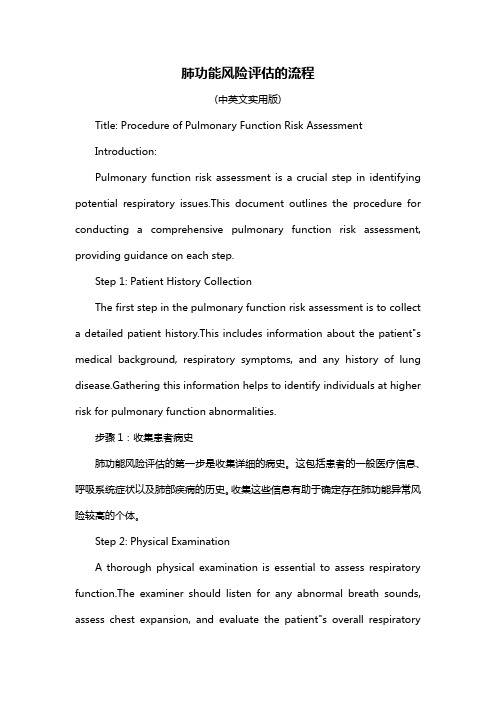
肺功能风险评估的流程(中英文实用版)Title: Procedure of Pulmonary Function Risk AssessmentIntroduction:Pulmonary function risk assessment is a crucial step in identifying potential respiratory issues.This document outlines the procedure for conducting a comprehensive pulmonary function risk assessment, providing guidance on each step.Step 1: Patient History CollectionThe first step in the pulmonary function risk assessment is to collect a detailed patient history.This includes information about the patient"s medical background, respiratory symptoms, and any history of lung disease.Gathering this information helps to identify individuals at higher risk for pulmonary function abnormalities.步骤1:收集患者病史肺功能风险评估的第一步是收集详细的病史。
这包括患者的一般医疗信息、呼吸系统症状以及肺部疾病的历史。
收集这些信息有助于确定存在肺功能异常风险较高的个体。
Step 2: Physical ExaminationA thorough physical examination is essential to assess respiratory function.The examiner should listen for any abnormal breath sounds, assess chest expansion, and evaluate the patient"s overall respiratoryeffort.Abnormal findings may indicate the need for further pulmonary function testing.步骤2:体格检查全面体检对于评估呼吸功能至关重要。
安全生产相关英文单词

安全生产相关英文单词Safety Production Related English Words and Phrases (1000 words)1. Safety production - 安全生产2. Occupational safety and health - 职业安全与健康3. Risk assessment - 风险评估4. Safety regulations - 安全法规5. Hazard identification - 危险识别6. Emergency response plan - 应急响应计划7. Safety audit - 安全审计8. Accident prevention - 事故预防9. Safety training - 安全培训10. Personal protective equipment (PPE) - 个人防护装备11. Hazardous substances - 危险物质12. Safety culture - 安全文化13. Fire safety - 火灾安全14. Incident investigation - 事故调查15. Workplace safety - 职场安全16. Safety management system - 安全管理体系17. Injury prevention - 伤害预防18. Safety signage - 安全标识19. Electrical safety - 电气安全20. Fall protection - 防坠落21. Hazard control - 危险控制22. Risk management - 风险管理23. First aid - 急救24. Safety inspection - 安全检查25. Personal safety - 人身安全26. Chemical safety - 化学品安全27. Ergonomics - 人体工学28. Machine safety - 机械安全29. Safety guidelines - 安全指导方针30. Safety committee - 安全委员会31. Safety equipment - 安全设备32. Safety standards - 安全标准33. Workplace hazards - 职场危险34. Safety precautions - 安全预防措施35. Noise control - 噪音控制36. Personal safety equipment - 个人安全装备37. Hazardous materials - 危险品38. Safety procedures - 安全程序39. Risk assessment matrix - 风险评估矩阵40. Safety protocols - 安全规程41. Safety regulations - 安全法规42. Safety training program - 安全培训计划43. Safety awareness - 安全意识44. Accident investigation - 事故调查45. Fire prevention - 火灾预防46. Safety guidelines - 安全指南47. Lockout/tagout - 锁定/标记48. Hazardous waste - 危险废物49. Emergency evacuation - 紧急疏散50. Health and safety regulations - 健康安全法规51. Safety inspection checklist - 安全检查清单52. Safety risk assessment - 安全风险评估53. Electrical hazard - 电气危险54. Hazardous area classification - 危险区分类55. Confined space safety - 有限空间安全56. Fire suppression systems - 灭火系统57. Safety procedures - 安全手册58. Hazardous energy control - 危险能源控制59. Safety protocols - 安全流程60. Risk mitigation - 风险缓解61. Emergency preparedness - 应急准备62. Safety signage - 安全标志牌63. Ergonomic assessment - 人体工程评估64. Safety equipment inspection - 安全设备检查65. Incident reporting - 事故报告66. Hazard communication - 危险品通报67. Fall arrest systems - 防坠落系统68. Process safety management - 工艺安全管理69. Safety training materials - 安全培训资料70. Safety performance indicators - 安全绩效指标71. Personal protective clothing - 个人防护服72. Lockout/tagout procedures - 锁定/标记程序73. Chemical hazard - 化学危险74. Safety work permit - 安全工作许可证75. Hazardous substances storage - 危险物质储存76. Emergency response team - 应急响应团队77. Safety risk management - 安全风险管理78. Fire extinguisher - 灭火器79. Safety signage requirements - 安全标识要求80. Hazardous waste disposal - 危险废物处理81. Incident analysis - 事故分析82. Safety equipment maintenance - 安全设备维护83. Personal safety procedures - 个人安全程序84. Hazard identification and assessment - 危险识别与评估85. Risk control measures - 风险控制措施86. Occupational illness prevention - 职业病预防87. Safety data sheets - 安全数据表88. Fire safety training - 火灾安全培训89. Safety improvement plan - 安全改进计划90. Hazardous materials storage - 危险物品储存91. Emergency evacuation plan - 紧急疏散计划92. Safety monitoring - 安全监测93. Incident reporting procedures - 事故报告程序94. Hazardous energy control procedures - 危险能源管控程序95. Safety policy - 安全政策96. Hazardous chemicals - 危险化学品97. Safety inspection report - 安全检查报告98. Hazardous substances handling - 危险物质处理99. Emergency response procedures - 应急响应程序100. Safety awareness training - 安全意识培训These are just some of the safety production-related English words and phrases that could be used in various contexts.。
EPA风险评估模型(英文)
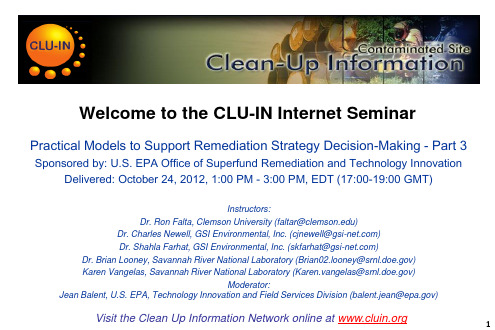
Information about Sponsors & Speakers
3
Practical Models to Support Remediation Strategy Decision-Making
Ronald W. Falta, Ph.D Brian Looney, Ph.D Charles J. Newell, Ph.D, P.E. Karen Vangelas Shahla K. Farhat, Ph.D
Welcome to the CLU-IN Internet Seminar
Practical Models to Support Remediation Strategy Decision-Making - Part 3
Sponsored by: U.S. EPA Office of Superfund Remediation and Technology Innovation Delivered: October 24, 2012, 1:00 PM - 3:00 PM, EDT (17:00-19:00 GMT)
REMChlor, REMFuel
Exploratory or decision level
Complex; Site-specific
Numerical Models (MODFLOW, Tough, RT3D)
Complex
6
INSTRUCTORS:
Ron Falta, Ph.D.
Professor, Dept. of Environmental Engineering & Earth Sciences, Clemson University
non-aqueous phase liquids, risk assessment, natural attenuation, bioremediation, software development, long term monitoring, non-point source studies
英文版风险评估模板27p

【经典资料,WORD文档,可编辑修改】【经典考试资料,答案附后,看后必过,WORD文档,可修改】RISK ASSESSMENT REPORT TEMPLATEInformation Technology Risk Assessment ForRisk Assessment Annual Document Review HistoryT ABLE OF C ONTENTS1INTRODUCTION (1)2IT SYSTEM CHARACTERIZATION (2)3RISK IDENTIFICATION (6)4CONTROL ANALYSIS (8)5RISK LIKELIHOOD DETERMINATION (12)6IMPACT ANALYSIS (14)7RISK DETERMINATION (16)8RECOMMENDATIONS (18)9RESULTS DOCUMENTATION (20)L IST OF E XHIBITSE XHIBIT 1:R ISK A SSESSMENT M ATRIX (20)L IST OF F IGURESF IGURE 1–IT S YSTEM B OUNDARY D IAGRAM (4)F IGURE 2–I NFORMATION F LOW D IAGRAM (5)L IST OF T ABLEST ABLE A: R ISK C LASSIFICATIONS (1)T ABLE B: IT S YSTEM I NVENTORY AND D EFINITION (2)T ABLE C: T HREATS I DENTIFIED (4)T ABLE D: V ULNERABILITIES,T HREATS, AND R ISKS (5)T ABLE E:S ECURITY C ONTROLS (6)T ABLE F:R ISKS-C ONTROLS-F ACTORS C ORRELATION (8)T ABLE G:R ISK L IKELIHOOD D EFINITIONS (9)T ABLE H:R ISK L IKELIHOOD R ATINGS (9)T ABLE I:R ISK I MPACT R ATING D EFINITIONS (14)T ABLE J:R ISK I MPACT A NALYSIS (14)T ABLE K:O VERALL R ISK R ATING M ATRIX (16)T ABLE L: O VERALL R ISK R ATINGS T ABLE (16)T ABLE M: R ECOMMENDATIONS (18)1 INTRODUCTIONRisk assessment participants:Participant roles in the risk assessment in relation assigned agency responsibilities: Risk assessment techniques used:2 IT SYSTEM CHARACTERIZATION2 IT SYSTEM CHARACTERIZATIONSensitivity Rating and ClassificationH IGHM ODERATEL OWIT System ClassificationMust be “Sensitive” if overall sensitivity is “high”; consider as “Sensitive” if overallsensitivity is “moderate”S ENSITIVEN ON-S ENSITIVEDescription or diagram of the system and network architecture, including all components of the system and communications links connecting the components of the system, associated data communications and networks:Figure 1 – IT System Boundary DiagramDescription or a diagram depicting the flow of information to and from the IT system, including inputs and outputs to the IT system and any other interfaces that exist to the system:Figure 2 – Information Flow Diagram3 RISK IDENTIFICATIONIdentification of VulnerabilitiesVulnerabilities were identified by:Identification of ThreatsThreats were identified by:Identification of RisksRisks were identified by:The way vulnerabilities combine with credible threats to create risks is identified Table D.4 CONTROL ANALYSISTable E correlates the risks identified in Table C with relevant IT security controls documented in Table D and with other mitigating or exacerbating factors.Risk No.Risk SummaryCorrelation of Relevant Controls & OtherFactors1 2 3 4 5 6 7 8 9101112131415161718192021222324255 RISK LIKELIHOOD DETERMINATIONTable G defines the risk likelihood ratings.Table G , evaluates the effectiveness of controls and the probability or motivation and capability of each threat to BFS and assigns a likelihood, as defined in Table F, to each risk documented in Table C. Risk No. Risk SummaryRisk Likelihood EvaluationRisk LikelihoodRating1 2 3 4 5 6 7 8 9 10 11 12Risk No.Risk Summary Risk Likelihood EvaluationRisk LikelihoodRating13141516171819Risk No.Risk Summary Risk Likelihood EvaluationRisk LikelihoodRating2021222324256 IMPACT ANALYSISTable I documents the ratings used to evaluate the impact of risks.Table J documents the results of the impact analysis, including the estimated impact forDescription of process used in determining impact ratings:7 RISK DETERMINATIONTable K documents the criteria used in determining overall risk ratings.Risk Scale: Low (1 to 10); Moderate (>10 to 50); High (>50 to 100) Table L assigns an overall risk rating, as defined in Table K, to each of the risks documented in Table D.Description of process used in determining overall risk ratings:8 RECOMMENDATIONSTable M documents recommendations for the risks identified in Table D.9 RESULTS DOCUMENTATIONExhibit 1: Risk Assessment Matrix。
(风险管理)风险分析及方法简述
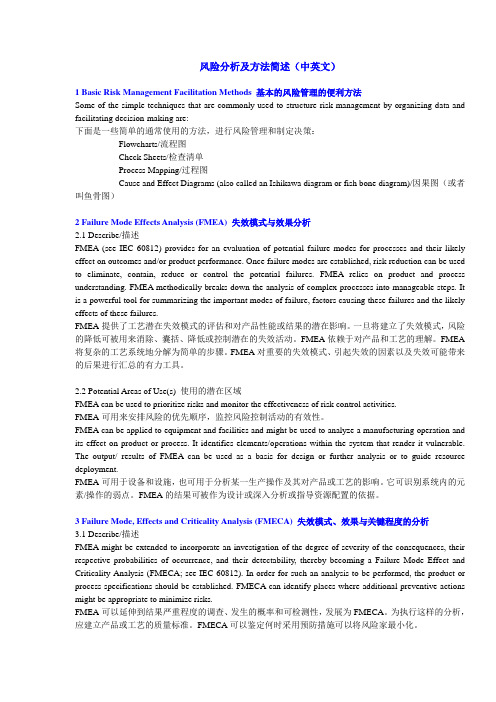
风险分析及方法简述(中英文)1 Basic Risk Management Facilitation Methods 基本的风险管理的便利方法Some of the simple techniques that are commonly used to structure risk management by organizing data and facilitating decision-making are:下面是一些简单的通常使用的方法,进行风险管理和制定决策:Flowcharts/流程图Check Sheets/检查清单Process Mapping/过程图Cause and Effect Diagrams (also called an Ishikawa diagram or fish bone diagram)/因果图(或者叫鱼骨图)2 Failure Mode Effects Analysis (FMEA) 失效模式与效果分析2.1 Describe/描述FMEA (see IEC 60812) provides for an evaluation of potential failure modes for processes and their likely effect on outcomes and/or product performance. Once failure modes are established, risk reduction can be used to eliminate, contain, reduce or control the potential failures. FMEA relies on product and process understanding. FMEA methodically breaks down the analysis of complex processes into manageable steps. It is a powerful tool for summarizing the important modes of failure, factors causing these failures and the likely effects of these failures.FMEA提供了工艺潜在失效模式的评估和对产品性能或结果的潜在影响。
危险源识别及风险评价控制程序(中英文)

危险源识别及风险评价控制程序Hazard source identification and risk evaluation control procedure(ISO45001:2017)1.目的Purpose:对本公司能够控制和可望施加影响的危险因素进行辨识和评价,并从中评价出重要危害因素,为建立职业健康安全目标指标﹐实施运行控制和改善安全卫生行为提供依据。
To identify and evaluate the controllable and excepted and influenced hazard aspects, identify the important hazard aspect, provide the reference for the establishment of the occupational health and safety objectives and the implementation of the operational control and the improvement of safety and health behavior.2.适用范围Application scope:本程序适用于公司产品、活动及服务等危害辨识和危险评价。
It is applicable to the hazard identification and evaluation for the company’s products, activities, services and etc..3.定义Definition:无N/A4.职责Responsibility:4.1 各部门:负责辨识和评价本部门的危害因素。
4.1 Each Department: To identify and evaluate the hazard aspect within the department.4.2 人力资源部:负责辨识和评价相关方的危害因素及危险因素的汇总﹑审核﹐组织评价和确定重要危险因素﹑各部门协助。
审计名词中英文对照

审计名词中英文对照1. 审计 Audit2. 内部审计 Internal Audit3. 外部审计 External Audit4. 财务报表审计 Financial Statement Audit5. 税务审计 Tax Audit6. 合规审计 Compliance Audit7. 管理审计 Management Audit8. 运营审计 Operational Audit9. 风险评估 Risk Assessment10. 审计证据 Audit Evidence11. 审计计划 Audit Plan12. 审计程序 Audit Procedure13. 审计报告 Audit Report14. 审计准则 Audit Standards15. 审计意见 Audit Opinion16. 审计范围 Audit Scope17. 审计目标 Audit Objective18. 审计风险 Audit Risk19. 审计抽样 Audit Sampling20. 审计师 Auditor审计名词中英文对照(续)21. 审计流程 Audit Process22. 审计方法 Audit Methodology23. 审计委员会 Audit Committee24. 审计轨迹 Audit Trail25. 审计漏洞 Audit Gap26. 审计师独立性 Auditor Independence27. 审计师职业道德 Auditor Professional Ethics28. 审计调整 Audit Adjustments29. 审计重要性 Audit Materiality30. 审计发现 Audit Findings31. 审计缺陷 Audit Deficiency32. 审计质量控制 Audit Quality Control33. 审计风险管理 Audit Risk Management34. 审计沟通 Audit Communication35. 审计后续行动 Audit Followup36. 审计报告意见类型 Types of Audit Opinions37. 审计师陈述 Auditor's Representation38. 审计师责任 Auditor's Responsibility39. 审计师专业判断 Auditor's Professional Judgment40. 审计师工作底稿 Auditor's Working Papers在审计的广阔天地中,这些名词如同行走的指南针,帮助我们精准地定位问题、分析情况并得出结论。
风险术语的英文对照
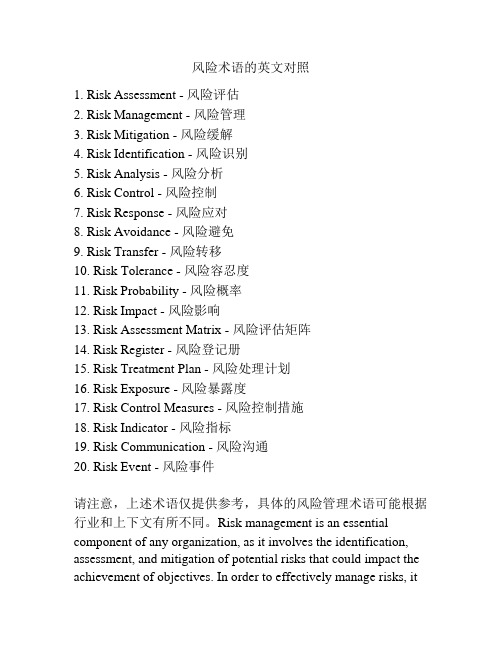
风险术语的英文对照1. Risk Assessment - 风险评估2. Risk Management - 风险管理3. Risk Mitigation - 风险缓解4. Risk Identification - 风险识别5. Risk Analysis - 风险分析6. Risk Control - 风险控制7. Risk Response - 风险应对8. Risk Avoidance - 风险避免9. Risk Transfer - 风险转移10. Risk Tolerance - 风险容忍度11. Risk Probability - 风险概率12. Risk Impact - 风险影响13. Risk Assessment Matrix - 风险评估矩阵14. Risk Register - 风险登记册15. Risk Treatment Plan - 风险处理计划16. Risk Exposure - 风险暴露度17. Risk Control Measures - 风险控制措施18. Risk Indicator - 风险指标19. Risk Communication - 风险沟通20. Risk Event - 风险事件请注意,上述术语仅提供参考,具体的风险管理术语可能根据行业和上下文有所不同。
Risk management is an essential component of any organization, as it involves the identification, assessment, and mitigation of potential risks that could impact the achievement of objectives. In order to effectively manage risks, itis crucial to have a clear understanding of various risk terminologies and their corresponding translations in English.Risk assessment, or 风险评估, is the process of identifying and evaluating potential risks to determine their likelihood and potential impact. This involves analyzing the probability of a risk occurring and assessing the potential consequences it could have on the organization. Risk assessments are typically conducted using various tools and techniques such as risk matrices, scenario analysis, and historical data.Once risks have been identified and assessed, the organization can proceed with risk management, or 风险管理. This involves developing strategies and action plans to minimize or eliminate the identified risks. Risk management aims to reduce the likelihood of a risk occurring or its potential impact if it does occur. It includes risk mitigation, or 风险缓解, which involves implementing measures to reduce the probability and/or severity of a risk.Risk identification, or 风险识别, is the process of identifying potential risks that could impact the organization's objectives. This includes analyzing internal and external factors that could lead to risks, such as changes in regulations, market volatility, or operational vulnerabilities. Risk analysis, or 风险分析, is the process of evaluating the identified risks to determine their potential impact and prioritize their treatment.Risk control, or 风险控制, involves implementing measures to reduce or manage the identified risks. This includes developingand implementing risk control measures, such as implementing safety protocols, conducting regular inspections, or implementing redundancy measures. Risk response, or 风险应对, refers to the actions taken by the organization to address identified risks. This could include accepting the risk, avoiding the risk, transferring the risk to a third party, or implementing measures to mitigate the risk.Risk avoidance, or 风险避免, refers to the strategy of completely eliminating the exposure to a particular risk. This could involve making changes to business processes, discontinuing certain activities, or avoiding certain markets or investments. Risk transfer, or 风险转移, involves transferring the responsibility and financial implications of a risk to another party, such as purchasing insurance coverage.Risk tolerance, or 风险容忍度, refers to the level of risk that an organization is willing to accept in order to achieve its objectives. This involves striking a balance between maximizing opportunities and minimizing potential risks. Risk probability, or 风险概率, refers to the likelihood or chance of a risk occurring. Risk impact, or 风险影响, refers to the magnitude of the consequences that would result if a risk were to occur.A risk assessment matrix, or 风险评估矩阵, is a tool used to evaluate and prioritize risks based on their likelihood and impact. It provides a visual representation of risks and helps in determining appropriate risk management strategies. A risk register, or 风险登记册, is a document that records all identified risks, along with their likelihood, potential impact, and mitigation measures.To implement effective risk management, organizations develop risk treatment plans, or 风险处理计划, which outline the specific actions to be taken to manage identified risks. These plans include a clear description of the risk, its potential impact, the desired risk treatment strategy, and the individuals responsible for its implementation.Risk exposure, or 风险暴露度, refers to the level of vulnerability or susceptibility of the organization to a particular risk. It considers the organization's potential financial, operational, and reputational losses resulting from a risk event. Risk control measures, or 风险控制措施, are actions implemented to mitigate or prevent identified risks. These measures may include implementing internal controls, conducting training programs, or investing in technologies to mitigate risks.Risk indicators, or 风险指标, are quantitative or qualitative measures used to monitor and assess risks. These indicators help in identifying early warning signs of emerging risks, enabling timely and proactive risk management. Risk communication, or 风险沟通, refers to the process of sharing information about risks within the organization or with external stakeholders. Effective risk communication is crucial for ensuring that everyone understands the risks, their potential impact, and the organization's strategiesfor managing them.Overall, understanding and utilizing risk terminologies in both English and their native language is vital for effective riskmanagement. It ensures clear communication, facilitates collaboration, and enhances the organization's ability to identify, assess, and mitigate risks. By effectively managing risks, organizations can safeguard their interests, minimize losses, and enhance their overall performance and resilience.。
质量安全风险评估英文
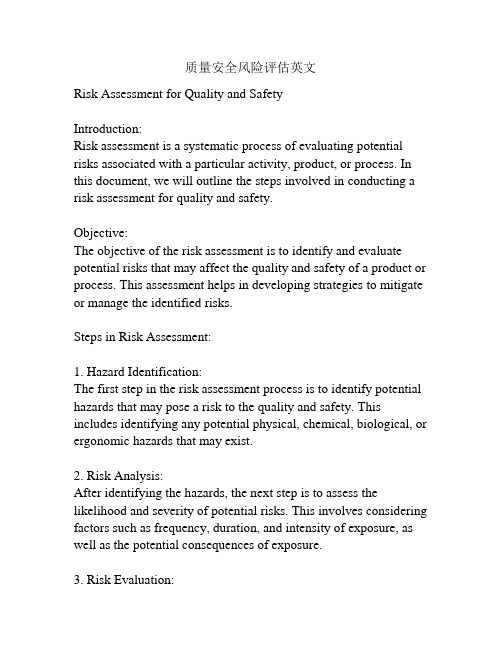
质量安全风险评估英文Risk Assessment for Quality and SafetyIntroduction:Risk assessment is a systematic process of evaluating potential risks associated with a particular activity, product, or process. In this document, we will outline the steps involved in conducting a risk assessment for quality and safety.Objective:The objective of the risk assessment is to identify and evaluate potential risks that may affect the quality and safety of a product or process. This assessment helps in developing strategies to mitigate or manage the identified risks.Steps in Risk Assessment:1. Hazard Identification:The first step in the risk assessment process is to identify potential hazards that may pose a risk to the quality and safety. This includes identifying any potential physical, chemical, biological, or ergonomic hazards that may exist.2. Risk Analysis:After identifying the hazards, the next step is to assess the likelihood and severity of potential risks. This involves considering factors such as frequency, duration, and intensity of exposure, as well as the potential consequences of exposure.3. Risk Evaluation:Once the risks have been analyzed, they should be evaluated based on their significance. This includes considering factors such as the impact on product quality, potential harm to individuals, and regulatory requirements.4. Risk Control:After evaluating the risks, the next step is to develop strategies and measures to control or mitigate the identified risks. This may involve implementing safety procedures, modifying the process or product design, or providing appropriate training and protective equipment.5. Risk Communication:Effective communication is essential in ensuring all relevant parties are aware of the identified risks and control measures. This includes communicating with employees, suppliers, customers, and regulatory authorities to promote understanding and collaboration in managing the risks.6. Risk Monitoring and Review:Risk assessment should be an ongoing process that is regularly reviewed and updated as new information or changes occur. Regular monitoring will help ensure that control measures remain effective and that any new risks are identified and addressed. Conclusion:Conducting a risk assessment for quality and safety is a crucial step in ensuring the integrity of products and processes. By following a systematic approach, potential risks can be identified,evaluated, and managed effectively, reducing the likelihood of quality or safety issues.。
肺功能风险评估的流程
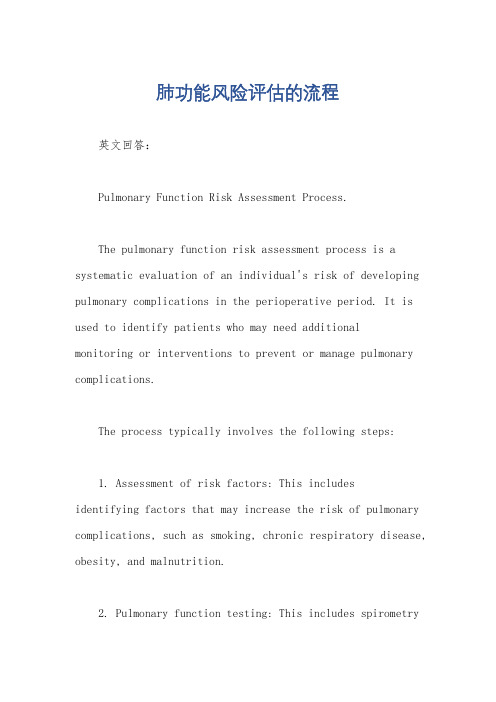
肺功能风险评估的流程英文回答:Pulmonary Function Risk Assessment Process.The pulmonary function risk assessment process is a systematic evaluation of an individual's risk of developing pulmonary complications in the perioperative period. It is used to identify patients who may need additionalmonitoring or interventions to prevent or manage pulmonary complications.The process typically involves the following steps:1. Assessment of risk factors: This includesidentifying factors that may increase the risk of pulmonary complications, such as smoking, chronic respiratory disease, obesity, and malnutrition.2. Pulmonary function testing: This includes spirometryand other tests to measure lung function and identify any abnormalities.3. Chest x-ray: This can help identify any structural abnormalities in the lungs that may increase the risk of complications.4. Other tests: These may include blood tests, electrocardiograms, and echocardiograms to assess overall health and identify any potential risks.Based on the results of the assessment, the individual is assigned a risk category:Low risk: Individuals with no significant risk factors and normal pulmonary function testing.Moderate risk: Individuals with some risk factors or mild abnormalities in pulmonary function testing.High risk: Individuals with multiple risk factors or significant abnormalities in pulmonary function testing.Individuals identified as high risk may require additional monitoring or interventions, such as:Pulmonary rehabilitation: This can help improve lung function and reduce the risk of complications.Supplemental oxygen: This can help improve oxygen levels and reduce the risk of hypoxia.Non-invasive positive pressure ventilation (NIPPV): This can help support breathing and reduce the risk of respiratory failure.The pulmonary function risk assessment process is an important part of preoperative planning. It helps to identify patients who are at risk of pulmonary complications and allows for the implementation of appropriate interventions to prevent or manage these complications.中文回答:肺功能风险评估流程。
风险评估用英语怎么说
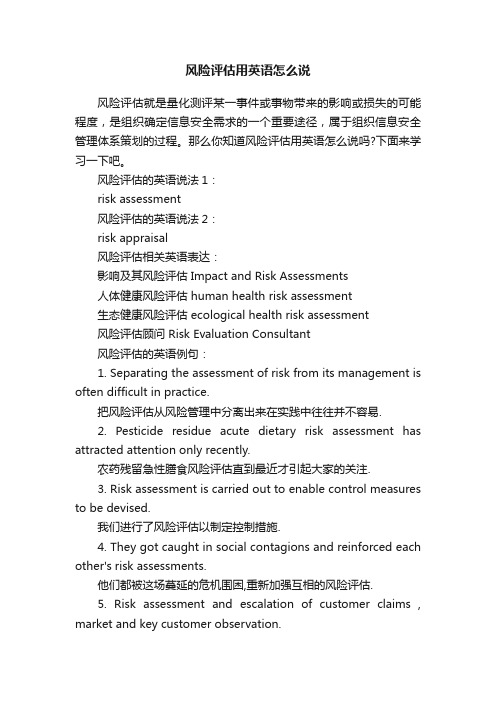
风险评估用英语怎么说风险评估就是量化测评某一事件或事物带来的影响或损失的可能程度,是组织确定信息安全需求的一个重要途径,属于组织信息安全管理体系策划的过程。
那么你知道风险评估用英语怎么说吗?下面来学习一下吧。
风险评估的英语说法1:risk assessment风险评估的英语说法2:risk appraisal风险评估相关英语表达:影响及其风险评估 Impact and Risk Assessments人体健康风险评估 human health risk assessment生态健康风险评估 ecological health risk assessment风险评估顾问 Risk Evaluation Consultant风险评估的英语例句:1. Separating the assessment of risk from its management is often difficult in practice.把风险评估从风险管理中分离出来在实践中往往并不容易.2. Pesticide residue acute dietary risk assessment has attracted attention only recently.农药残留急性膳食风险评估直到最近才引起大家的关注.3. Risk assessment is carried out to enable control measures to be devised.我们进行了风险评估以制定控制措施.4. They got caught in social contagions and reinforced each other's risk assessments.他们都被这场蔓延的危机围困,重新加强互相的风险评估.5. Risk assessment and escalation of customer claims , market and key customer observation.对客户要求进行风险评估和调整, 对市场和主要客户进行观察测评.6. Workshop on Environmental Monitoring and Risk Assessment of Persistent Organic Pollutants ( POPs ).持久性有机污染物的环境监测及风险评估技术工作坊.7. This thesis is a system of the risk assessment of LPG carrier.本文是液化气船风险评估的一个子系统.8. It is the base and precondition of information system security.在这项系统工程中,信息系统安全风险评估占有重要的地位,它是信息系统安全的基础和前提.9. The main contents and aims of lightning stroke assessment are discussed.对雷击风险评估的主要内容和目的进行了探讨.10. Model - driven assessment approach has significant meaning for information security assessment.基于模型的评估方法对信息安全风险评估具有重要的意义.11. May distinguish the risk size through the network risk assessment.通过网络风险评估,可识别风险大小.12. At the moment, Europe's rules on pesticides are based on risk.欧洲目前的农药法规是以风险评估为基础的.13. Risk assessments should be performed by appropriate subject matter experts.4风险评估应该由适当的专门领域的专家进行.14. That's Vicky Pope about the range of possible risks of climate change.维琦?波普正在谈论气候变化风险评估结果的波动范围.15. Other controls are affected as a result of risk assessment.风险评估的结果影响了其他方面因素的控制.。
风险评估细则(中英文)_供应商-MQ-0002
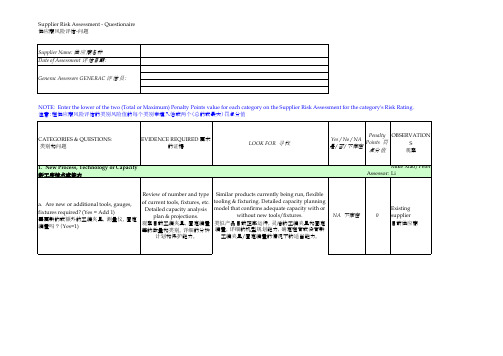
commercial generator or GPE. (No = Add 7) 供应商有发电机或通机经验吗?如果 有,注意是轻型或商用发电机或通机(没有 =加7分)
P.O.'s or shipping documents confirming this. 用订单号或运输单据来证实
Review of number and type of current tools, fixtures, etc.
Detailed capacity analysis plan & projections.
观察目前工装夹具,固定装置 等的数量和类别。详细的分析
计划和保护能力。
Similar products currently being run, flexible tooling & fixturing. Detailed capacity planning model that confirms adequate capacity with or
If yes, record the supplier location(s) and the division each location currenlty supplies.如果 是,记录下供应商的这些地点以及目前每个地点
供应的GENERAC部门。
Yes 是
Existing 0 supplier 目前供
Supplier Risk Assessment - Questionaire 供应商风险评估-问题
Supplier Name: 供 应 商名称 Date of Assessment 评 估日期 :
Generac Assessors GENERAC 评 估 员 :
跌倒风险评估的流程
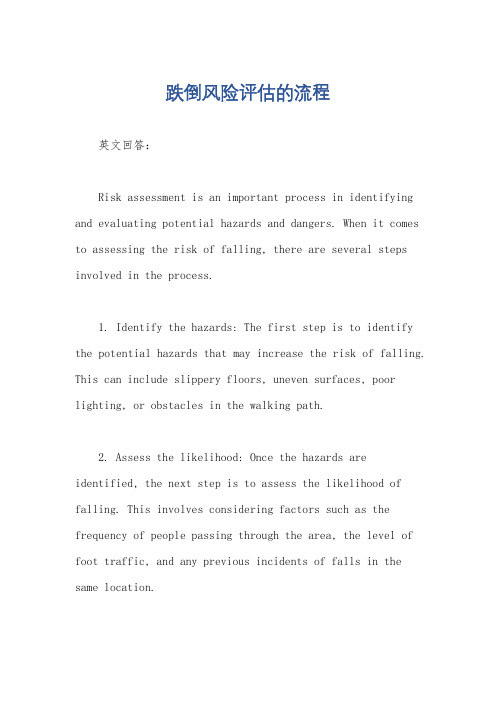
跌倒风险评估的流程英文回答:Risk assessment is an important process in identifying and evaluating potential hazards and dangers. When it comes to assessing the risk of falling, there are several steps involved in the process.1. Identify the hazards: The first step is to identify the potential hazards that may increase the risk of falling. This can include slippery floors, uneven surfaces, poor lighting, or obstacles in the walking path.2. Assess the likelihood: Once the hazards are identified, the next step is to assess the likelihood of falling. This involves considering factors such as the frequency of people passing through the area, the level of foot traffic, and any previous incidents of falls in the same location.3. Evaluate the consequences: After assessing the likelihood, it is important to evaluate the potential consequences of a fall. This can include the severity of injuries that may occur, the impact on the individual's quality of life, and any potential financial implications.4. Determine the risk level: Based on the likelihoodand consequences, the risk level can be determined. Thiscan be classified as low, medium, or high risk. For example, if there is a high likelihood of falling due to a slippery floor and the consequences can be severe, then the risklevel would be considered high.5. Implement preventive measures: Once the risk levelis determined, appropriate preventive measures should be implemented. This can include installing handrails, improving lighting, providing non-slip flooring, or removing obstacles in the walking path. These measures aimto reduce the likelihood of falling and mitigate the potential consequences.6. Regular review and monitoring: Risk assessmentshould not be a one-time process. It is important to regularly review and monitor the effectiveness of the preventive measures in place. This can involve conducting periodic inspections, gathering feedback from individuals using the area, and making necessary adjustments to ensure ongoing safety.By following these steps, a comprehensive risk assessment for falling can be conducted, leading to the implementation of effective preventive measures and ultimately reducing the risk of falls.中文回答:跌倒风险评估是识别和评估潜在危险和风险的重要过程。
安全隐患识别5步流程
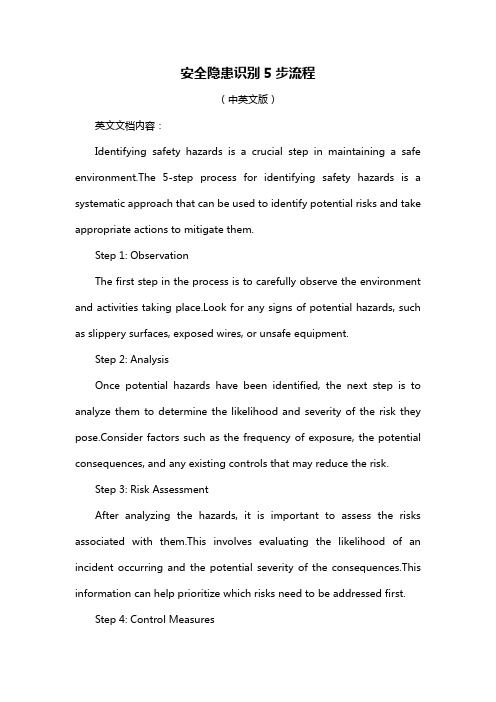
安全隐患识别5步流程(中英文版)英文文档内容:Identifying safety hazards is a crucial step in maintaining a safe environment.The 5-step process for identifying safety hazards is a systematic approach that can be used to identify potential risks and take appropriate actions to mitigate them.Step 1: ObservationThe first step in the process is to carefully observe the environment and activities taking place.Look for any signs of potential hazards, such as slippery surfaces, exposed wires, or unsafe equipment.Step 2: AnalysisOnce potential hazards have been identified, the next step is to analyze them to determine the likelihood and severity of the risk they pose.Consider factors such as the frequency of exposure, the potential consequences, and any existing controls that may reduce the risk.Step 3: Risk AssessmentAfter analyzing the hazards, it is important to assess the risks associated with them.This involves evaluating the likelihood of an incident occurring and the potential severity of the consequences.This information can help prioritize which risks need to be addressed first.Step 4: Control MeasuresBased on the risk assessment, develop and implement control measures to eliminate or reduce the risk to an acceptable level.This may involve implementing safety protocols, providing training, or making physical changes to the environment.Step 5: Review and ImprovementLastly, it is important to regularly review the effectiveness of the control measures and make any necessary improvements.This may involve updating policies and procedures, providing additional training, or making changes to the physical environment.By following this 5-step process, potential safety hazards can be identified and addressed in a timely and effective manner, helping to maintain a safe environment for all.中文文档内容:识别安全隐患是维护安全环境的重要步骤。
kyc流程
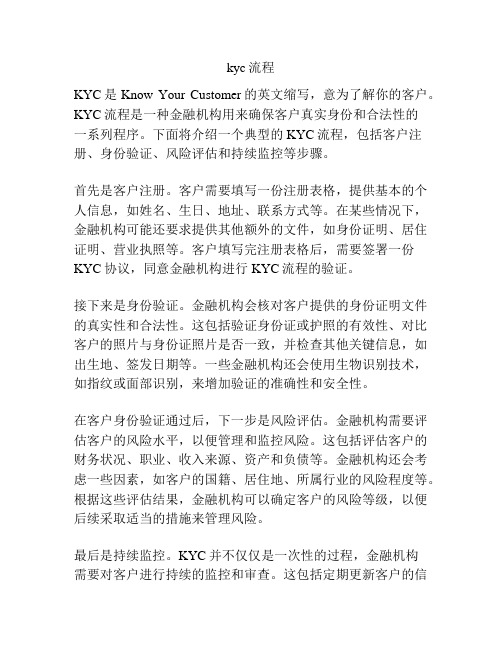
kyc流程KYC是Know Your Customer的英文缩写,意为了解你的客户。
KYC流程是一种金融机构用来确保客户真实身份和合法性的一系列程序。
下面将介绍一个典型的KYC流程,包括客户注册、身份验证、风险评估和持续监控等步骤。
首先是客户注册。
客户需要填写一份注册表格,提供基本的个人信息,如姓名、生日、地址、联系方式等。
在某些情况下,金融机构可能还要求提供其他额外的文件,如身份证明、居住证明、营业执照等。
客户填写完注册表格后,需要签署一份KYC协议,同意金融机构进行KYC流程的验证。
接下来是身份验证。
金融机构会核对客户提供的身份证明文件的真实性和合法性。
这包括验证身份证或护照的有效性、对比客户的照片与身份证照片是否一致,并检查其他关键信息,如出生地、签发日期等。
一些金融机构还会使用生物识别技术,如指纹或面部识别,来增加验证的准确性和安全性。
在客户身份验证通过后,下一步是风险评估。
金融机构需要评估客户的风险水平,以便管理和监控风险。
这包括评估客户的财务状况、职业、收入来源、资产和负债等。
金融机构还会考虑一些因素,如客户的国籍、居住地、所属行业的风险程度等。
根据这些评估结果,金融机构可以确定客户的风险等级,以便后续采取适当的措施来管理风险。
最后是持续监控。
KYC并不仅仅是一次性的过程,金融机构需要对客户进行持续的监控和审查。
这包括定期更新客户的信息,如联系方式、居住地址等;对客户的交易进行监控,以发现任何可疑的活动;并根据需要重新评估客户的风险等级。
金融机构还会遵守当地法律和监管要求,向监管机构报告客户交易中可能存在的高风险活动。
综上所述,KYC流程是一种金融机构用来了解客户及其风险状况的一系列程序。
通过客户注册、身份验证、风险评估和持续监控等步骤,金融机构可以确保客户的真实身份和合法性,并对风险进行有效管理和监控。
这不仅有助于保护金融机构免受洗钱、恐怖主义融资等非法活动的影响,也有助于维护金融市场的健康和稳定。
